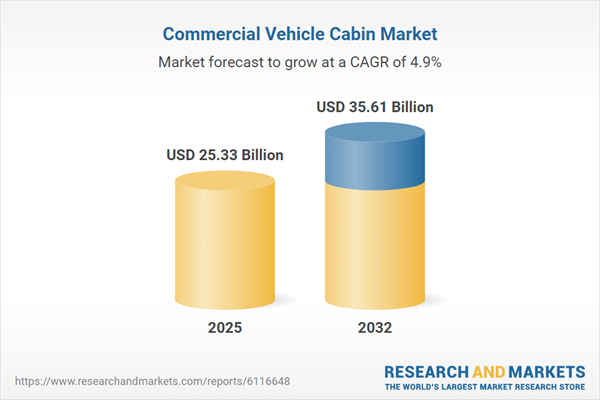Speak directly to the analyst to clarify any post sales queries you may have.
The commercial vehicle cabin market is undergoing rapid transformation, driven by regulatory mandates, digital integration, and evolving driver expectations. Senior decision-makers must navigate complex dynamics as cabins move from basic enclosures to interconnected, intelligent workspaces that support both safety and operational efficiency.
Market Snapshot: Commercial Vehicle Cabin Market Growth and Outlook
The Commercial Vehicle Cabin Market grew from USD 24.22 billion in 2024 to USD 25.33 billion in 2025. It is expected to continue growing at a CAGR of 4.93%, reaching USD 35.61 billion by 2032. This expansion is fueled by heightened safety requirements, digital connectivity demands, and advancements in materials science. Cabin design now balances regulatory compliance with operational needs, resulting in innovative approaches to driver comfort and fleet efficiency.
Scope & Segmentation
This report delivers granular insights across strategic market segments, enabling informed allocation of resources. Segmentation guides optimized portfolio strategies and regional market entry decisions.
- Vehicle Types: Heavy commercial vehicles, light commercial vehicles, medium commercial vehicles
- Cabin Types: Sleeper cabins, standard cabins
- Materials: Aluminum, composite, steel
- Sales Channels: Aftermarket, original equipment manufacturer (OEM)
- End Users: Fleet operators, government & defense agencies, individual owners
- Regions: Americas, Europe, Middle East, Africa, Asia-Pacific (including specific country coverage)
- Leading Companies Profiled: Mercedes-Benz Group AG, Volvo Group, BYD Company Ltd., CNH Industrial N.V., Dongfeng Motor Corporation, FAW Group Corporation, Fortaco Group, Hino Motors Ltd. by Toyota Motor Corporation, Hyundai Motor Company, Isuzu Motors Limited, Mahindra & Mahindra Limited, Mitsubishi Fuso Truck and Bus Corporation, Oshkosh Corporation, Oy Sisu Auto Ab, Paccar Inc., Prabha Group, Scania AB by Volkswagen Group, Tata Motors Limited, ZAGRO Group
Key Takeaways for Senior Decision-Makers
- Digitalization and connectivity are reshaping the operator workspace, driving expectations for telematics, real-time diagnostics, and seamless integration with fleet management platforms.
- Cabin innovations focus on occupant well-being, incorporating ergonomic seating, ambient lighting, modular setups, and intuitive controls that reduce fatigue and support diverse usage profiles.
- Electrification and powertrain evolution introduce new thermal management complexities, pushing adoption of lightweight, energy-efficient materials and advanced HVAC systems in both traditional and electric commercial vehicles.
- Regional differences guide cabin customization. In the Americas, ergonomic and safety features are pivotal, while Europe, Middle East, and Africa emphasize modularity and lightweight materials to comply with regulatory constraints and diverse operating environments.
- OEMs and suppliers accelerate value creation by investing in R&D, forging alliances, and executing targeted acquisitions. This approach enables faster adaptation to trends in both primary and aftermarket sales.
- Tariff measures are prompting near-sourcing strategies and modular design approaches, reducing exposure to global supply disruptions and boosting regional control over costs and components.
Tariff Impact on the Commercial Vehicle Cabin Ecosystem
Recent US tariffs on steel, aluminum, and electronic assemblies have significantly affected import costs and supply chain strategies. Key players respond by consolidating manufacturing near major OEMs, diversifying supply sources, and renegotiating contracts to include tariff-adaptive clauses. Modular platforms that allow flexibility in material sourcing and regional subassemblies are rising in prominence. As a result, supply networks are more resilient, but lead times and buffer inventories have also increased to accommodate market volatility.
Methodology & Data Sources
This analysis employs a robust methodology integrating primary interviews with executives, fleet managers, and engineers, as well as secondary research from industry reports, regulatory filings, and technical journals. Insights are validated through peer review and subject matter expert consultations, ensuring actionable and reliable intelligence for decision-makers in the commercial vehicle cabin market.
Why This Report Matters
- Equips leadership teams with a clear understanding of the market drivers, technology adoption, and tariff effects shaping future cabin architectures.
- Supports strategic planning, R&D investment, and value chain partnerships by pinpointing high-growth regions and key customer requirements.
- Delivers an actionable segmentation framework, enabling agile product development and competitive benchmarking across OEM and aftermarket segments.
Conclusion
The commercial vehicle cabin market is advancing quickly as new technologies and regulations reshape design imperatives. Strategic focus on digital integration, resilient sourcing, and regional alignment will drive sustained growth and competitive differentiation.
Table of Contents
3. Executive Summary
4. Market Overview
7. Cumulative Impact of Artificial Intelligence 2025
Companies Mentioned
The companies profiled in this Commercial Vehicle Cabin market report include:- Mercedes-Benz Group AG
- Volvo Group
- BYD Company Ltd.
- CNH Industrial N.V.
- Dongfeng Motor Corporation
- Dongfeng Motor Corporation
- FAW Group Corporation
- Fortaco Group
- Hino Motors, Ltd. by Toyota Motor Corporation
- Hyundai Motor Company
- Isuzu Motors Limited
- Mahindra & Mahindra Limited
- Mitsubishi Fuso Truck and Bus Corporation
- Oshkosh Corporation
- Oy Sisu Auto Ab
- Paccar Inc.
- Prabha Group
- Scania AB by Volkswagen Group
- Tata Motors Limited
- ZAGRO Group
Table Information
| Report Attribute | Details |
|---|---|
| No. of Pages | 187 |
| Published | October 2025 |
| Forecast Period | 2025 - 2032 |
| Estimated Market Value ( USD | $ 25.33 Billion |
| Forecasted Market Value ( USD | $ 35.61 Billion |
| Compound Annual Growth Rate | 4.9% |
| Regions Covered | Global |
| No. of Companies Mentioned | 21 |









